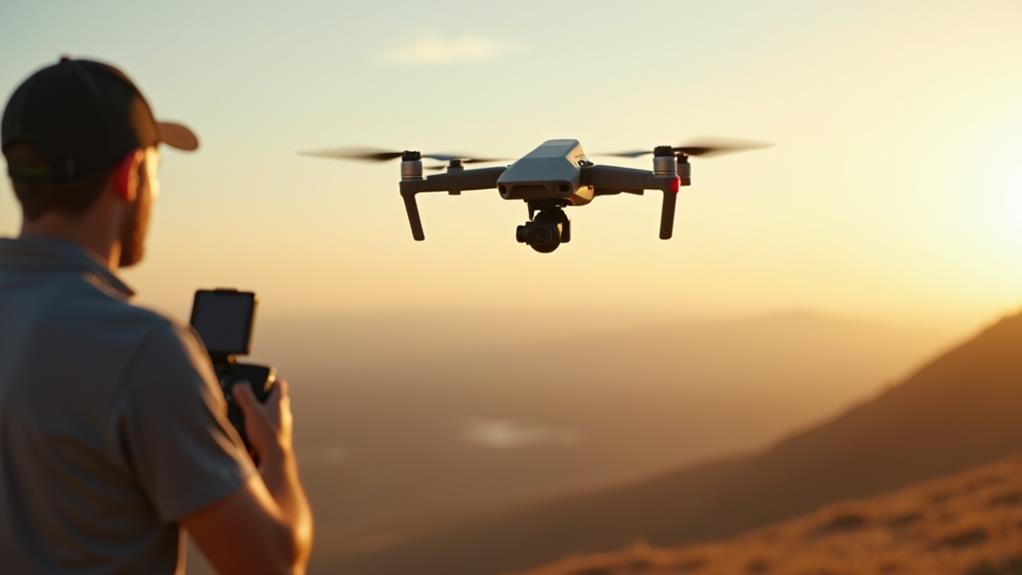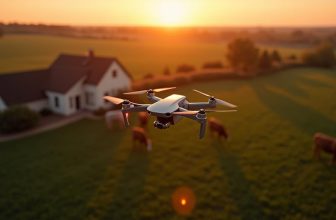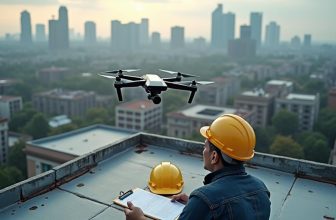
When it comes to capturing stunning cinematic footage, you’ll want a drone that combines exceptional camera capabilities with advanced flight features. You’re likely looking for a drone that can deliver high-resolution images, smooth video, and precise control. If you’re on a budget, you might be surprised to find that some affordable options, like the DJI Mini 2, can still provide impressive results. But what makes these drones truly stand out, and how do they compare to high-end models designed for professional filmmakers? Let’s explore the key features and top picks that can help you achieve cinematic excellence.
Contents
Key Takeaways
- Larger sensors and high-quality cameras provide better low-light performance and color accuracy for cinematic footage.
- Advanced autopilot systems with GPS and IMU enable stable flight and obstacle avoidance for smooth footage.
- High-resolution cameras with wide-angle lenses and adjustable apertures offer creative control and flexibility for filmmakers.
- Custom flight modes and tailored drone behavior enable capturing high-quality, complex aerial shots and scenes.
- A stable and high-quality camera system with gimbal design and lens calibration is essential for capturing crisp and clear images.
Key Features to Consider
When considering drones for cinematic filming, you’ll want to focus on the drone’s key features that directly impact the quality of your footage.
A pivotal aspect is the sensor size, as it affects the overall image quality. A larger sensor size allows for better low-light performance, increased dynamic range, and improved color accuracy. This results in more detailed and cinematic footage.
Another critical feature is flight autonomy, which refers to the drone’s ability to navigate and stabilize itself during flight.
Advanced flight autonomy systems, such as obstacle avoidance and tracking modes, enable you to focus on capturing stunning footage while the drone handles the complex flight maneuvers. Look for drones with advanced autopilot systems, such as GPS and IMU, which provide smooth and stable flight.
Additionally, consider the drone’s camera specifications, including resolution, frame rate, and lens quality.
A high-resolution camera with a wide-angle lens and adjustable aperture will provide you with more creative control and flexibility when shooting. By prioritizing these key features, you’ll be able to capture high-quality, cinematic footage that meets your artistic vision.
Top Picks for Budget Filmmakers
With key features in mind, you’re ready to explore top picks for budget filmmakers.
As a filmmaker on a budget, you need drones that can deliver high-quality footage without breaking the bank.
Here are some budget breakthroughs that offer filmmaker essentials:
- DJI Mini 2: A compact drone with 4K video capabilities, 12MP photos, and a 3-axis gimbal for smooth footage.
- Autel EVO II: A budget-friendly drone with 8K video, 48MP photos, and a 1-inch CMOS sensor for excellent low-light performance.
- Holy Stone HS100: A mid-range drone with 4K video, 12MP photos, and a 3-axis gimbal for stable footage.
- Potensic D58: A budget-friendly drone with 2.7K video, 12MP photos, and a 2-axis gimbal for smooth footage.
These drones offer excellent value for their price, making them ideal for budget filmmakers.
They provide essential features like 4K video, high-quality cameras, and stable gimbals, allowing you to capture stunning footage without overspending.
When choosing a drone, consider your specific needs and preferences to find the best fit for your filmmaking style.
High-End Drones for Professionals
As a professional filmmaker, you’re likely no stranger to the pursuit of cinematic perfection.
When it comes to high-end drones for professionals, you need a machine that can keep up with your creative vision. Look for drones with advanced flight capabilities, such as multiple flight modes, to achieve complex aerial choreography.
The ability to switch between different flight modes seamlessly is vital for capturing dynamic shots.
For instance, using the “Orbit” mode, you can capture stunning 360-degree shots around your subject. Meanwhile, “Follow” mode allows you to track your subject from various angles and heights, adding depth and visual interest to your shots.
High-end drones often feature custom flight modes that allow you to tailor the drone’s behavior to specific shots or scenes.
With advanced GPS and sensors, these drones can maintain precise control and stability, even in complex aerial maneuvers. This level of control and precision is essential for capturing high-quality, cinematic footage that will elevate your film to the next level.
Camera Stabilization and Quality
A stable and high-quality camera system is essential for capturing cinematic footage that leaves a lasting impression on your audience.
When it comes to camera stabilization and quality, you want a drone that can deliver smooth and precise footage, even in turbulent conditions.
The gimbal design plays a pivotal role in camera stabilization, allowing for precise control over camera movement and orientation.
- Lens calibration is also indispensable, as it guarantees that the camera’s optical system is perfectly aligned, resulting in crisp and clear images.
- High-quality cameras often feature advanced sensors and lenses that can capture a wide range of tonal values and colors, resulting in more cinematic footage.
- Additionally, features like optical zoom and adjustable aperture allow you to fine-tune your camera settings to achieve the desired look and feel.
When evaluating a drone’s camera system, look for features that prioritize stability and image quality.
A well-designed gimbal and high-quality camera can make all the difference in capturing stunning cinematic footage.
Additional Must-Have Accessories
Capturing cinematic footage with a drone requires more than just a high-quality camera system – this necessitates a range of specialized accessories that can elevate your filmmaking to new heights.
As you prepare to take your drone on a shoot, having the right gear is vital to protect it and enhance your filming experience.
Invest in Proprietary Cases that are specifically designed for your drone model, offering a snug fit and adequate padding to safeguard your device during transport.
These cases also often feature custom-cut foam inserts that cradle the drone and its accessories, minimizing movement and reducing the risk of damage.
When it comes to monitoring your footage, an External Monitor is an invaluable accessory.
It allows you to review your shots in real-time, adjusting camera settings and framing with precision.
Look for a monitor with a high-resolution display and a compact design that won’t weigh you down.
With these accessories in your toolkit, you’ll be well-equipped to capture stunning cinematic footage and take your filmmaking to new heights.
FAQs: Drones for Cinematic Filming
Can I Fly a Drone for Filming Without a License?
You’ll likely need drone permits to fly for filming, as aerial regulations vary by location and type of flight. Check with local authorities to confirm compliance with specific requirements for capturing desired footage.
How Do I Prevent Drone Theft During Filming?
When filming on location, you’ll want to take steps to prevent drone theft. Consider adding unique drone markings and installing GPS tracking devices to quickly locate your drone if it’s lost or stolen.
Can I Use a Drone for Indoor Cinematic Filming?
Can you navigate a drone through a crowded indoor space without crashing? For indoor cinematic filming, you must consider indoor obstacles and flight restrictions, choosing a drone with precision control, GPS, and advanced stabilization features.
Are Insurance Plans Available for Cinematic Drones?
You can find insurance plans specifically for drones, including specialized film equipment coverage, offering protection against damage, loss, or liability, with many providers offering customizable drone policies to suit your unique filming needs.
Can I Customize My Drone for Specific Filming Needs?
You’re likely one of the 70% of cinematographers who seek tailored solutions. For specific filming needs, you can customize your drone with Aerial Upgrades, such as high-resolution cameras, and Custom Payloads, like stabilized gimbals.
Conclusion
You’ve got the skills, you’ve got the vision – now it’s time to capture cinematic perfection. Whether you’re a budget filmmaker or a seasoned pro, the right drone is key. With premium cameras, advanced autopilot systems, and obstacle avoidance, you’ll be taking your aerial footage to new heights. Invest in the best, and you’ll soar with stunning 4K shots, effortless flight modes, and unparalleled stabilization – elevating your filmmaking to an art form.






